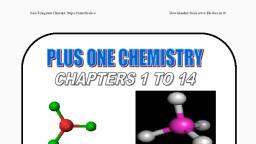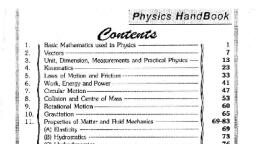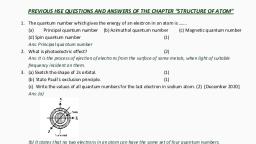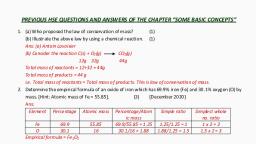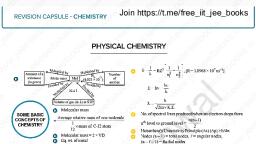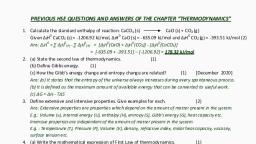Page 1 :
IMPORTANT FACTS AND FORMULAE FOR JEE, , IIT – CHEMISTRY, SOME BASIC CONCEPTS, 1., , 1 mole = NAvg u number of species = 6.023 u 1023 species, , 2., , i.e., atoms, molecules, ions, etc., Atomic mass, = Mass of one atom, Gram-atomic mass = Mass of one mole of atoms, = Mass of 6.023 u 1023 atoms in gms., e.g. Atomic mass of O is 16 amu., gm-atomic mass of O is 16 gm., ? 16 gm O-contains 6.023 u 1023 oxygen atoms., Atomic mass =, , Average mass of an atom, 1/12 u Mass of an atom of C12, , Average atomic mass =, , R.A.(1) u M.No + R.A.(2) u M.No, R.A.(1)+ R.A.(2), , Here R.A = Relative Abundance, Mass No. = Mass number., 3., , 1 amu (atomic mass unit) =, , =, , 4., , 1, = 1 Avogram, NAvg, 1, 6.023 u 1023, , gm = 1.66 u 10-24 gm = 1 Dalton, , Molecular weight = Weight of one molecule, Molar mass or gm-molecular weight = weight of one mole of molecule, = wt. of 6.023 u 1023 molecules, , 5., , Moles =, , Weight(gm), volume of gas at STP(L), =, Molar mass (gm / mole), 22.4 lit., , = Molarity u Volume (in L), , @iitandneetwale on telegram
Page 3 :
10., 11., , Molar volume = volume of 1 mole of gas at NTP/STP = 22.4 L or 22400, mL, Dulong and Petit’s law :, 6.4, Atomic mass (approx.) =, (for metals only) (cal/g), specific heat, The law is applicable only to solid elements except Be, B, C and Si., Approx. Atomic mass, Valency =, Eqv. mass, , 12., , The exact valency is a whole number nearest to the approximate valency, calculated. The exact valency is multiplied by the Eqv. mass to get, Atomic mass., Exact atomic mass = Exact valency u Eq. mass., Relation between molecular and empirical formulae :, Molecular formula = n u Empirical formula, Molecular formula weight, ?n =, Empirical formula weight, , 13., , Molarity =, , Moles of solute, volume of solution (L), , 14., , Molality =, , mole of solute, mass of solvent(kg), , 15., , Mole fraction = mole fraction of A in mixture of A and B = XA =, mole fraction of B in mixture of A and B = XB =, , nA, nA + nB, , nB, n A + nB, , number of gm equivalent of solute, volume of solution(L), , 16., , Normality =, , 17., , Atomicity (J ) =, , Cp, Cv, , (1.66 for mono-atomic, 1.4 for di-atomic, 1.33 for tri-, , atomic gas), At mass of gaseous element =, , mol. mass, Atomicity, , (Atomicity = number of atoms present in a molecule of the element)., Cp – Cv = R = 1.98 cal mol-1 K-1, Molar heat = specific heat u mol. mass, , @iitandneetwale on telegram
Page 4 :
STATES OF MATTER, Boyle’s law, PV = constant [at constant n, T], Charle’s, V, = constant, T, , [at constant n, P], , ? P1V1 = P2V2, , ?, , V1 V2, =, ;, T1 T2, , t ·, §, Vt = V0 ¨1+, [T (kelvin) = 273 + t (0C)], 273 ¸¹, ©, Gay-Lussac’s law, P, P, P, = constant [at constant n, V], ? 1 = 2, T, T1 T2, Ideal gas equation, PV, = R = 0.0821 l. atm.K-1 mol-1, nT, = 1.987 Cal K-1 mol-1 = 8.314 J K-1 mol-1, 1 atm = 760 mm of Hg = 76 cm of Hg = 101325 pascal ; 1 bar = 0.9862, Atm, Standard Temperature and pressure (STP) or Normal Temperature and, Pressure (NTP), P = 1 atm, T = 00 C or 273 K, Density and molar mass relation, PM, Density (d) =, RT, Dalton’s law of Partial Pressure, PTotal = P1 + P2 + P3 + ..……, Where P1, P2,…..etc. are partial pressures of individual gases., Partial pressure = Total pressure u mole function, Partial pressure of water in air, Relative Humidity =, Vapour pressure of water, Vap. Pressure of dry gas = Vap. Pressure of wet gas – Vap. pressure of, water vapour (aqu. tension), , @iitandneetwale on telegram
Page 6 :
a ·, §, i) At low pressure : ¨ p + 2 ¸ V = RT, v ¹, ©, ii) At high pressure : P (V - b) = RT, Units of a are atm L2 mol-2 and b are L mol-1, Greater is the value of a means gas can be easily liquefied, 4 3º, ª, Co-volume or excluded volume = 4N0Vm, « Vm = 3 Sr », ¬, ¼, i) Collision frequency, Z =, ii) Mean free path (O ) =, , SC Avg V2 (N / V)2, 2, V, , , where V =molecular diameter, 2SV2N, N/V = number of molecules per unit volume, , Nature of Gas Constant R, P u V Pressure u Volume (Force / Area) u (Volume), Force u Length, R=, =, =, =, nT, Moles u Degree(K), Moles u Degree(K), Moles u Degree(K), = Work done per degree per mole, Units of gas constant (R), R = 0.0821 atm L K-1 mol-1 = 0.0821 atm dm3 K-1 mol-1, (Here P = 1 atm, V = 22.4 L, T = 273 K, 1 L = 1 dm3), If P is expressed in dynes per square centimeter, (P = 76 u 981 u 13.6 dyne /cm2 ), V = 22400 dm3 and T = 273 K, then R = 8.314 u107 ergs K-1 mol-1 = 8.314 J K-1 mol-1 and R = 1.987cal K1 mol-1, 1 atm. Pressure = 0.76 m u 13.6 u 103 kg m-3 u 9.81ms-2 = 101.325 u 103, Nm-2 = 101.325 u 103 Pa, , ['1 Nm-2 = 1 Pa], , Thus, the gas constant R =, , [' 1 eV = 1.602 u 10-19, , (101.325 u 103 Nm-2 ) u (22400 u 10-6 m3 ), (273K) u (1mol), , = 8.314 Nm K-1 mol-1, = 5.189 u 1019 eVK-1 mol-1, volts coulomb (Joule)], , @iitandneetwale on telegram
Page 7 :
i), , Avogadro’s Law, V v n or V v N (at constant T, P), , ii), , Calculation of Kinetic Energy, According to gas equation, PV =, , 1, Mu2 for 1 mole of gas, 3, , 2 1, u Mu2, 3 2, 1, 3, 3, or Mu2 = PV = RT = K.E., 2, 2, 2, For 1 molecule, the K.E., or PV =, , R, ½, 3 RT 3, = K (Boltzmann constant)¾, = KT ®, 2 N0 2, ¯ N0, ¿, Average molecular weight of a gaseous mixture, ¦ ni Mi, Mmix =, where ni is the number of moles and Mi is the, ¦ ni, =, , iii), , vi), , molecular weight of the component., a, Critical Pressure (PC) : PC =, 27b 2, 8a, Critical Temperature (TC) : TC =, 27Rb, Critical Volume (VC) : VC = 3b, , vii), , Relationship between PC, VC and TC :, , viii), , Boyle’s Temperature : TB =, , iv), v), , PC TC 3, =, RTC, 8, , a, bR, , ATOMIC STRUCTURE, Planck’s Quantum theory, hc, E = hv =, O, Where, h = Planck’s constant (6.023 u 10-34 Js), v = Frequency of, radiation, c = Velocity of light, O = wavelength of radiation, 1, c = vO, O and wave number (v) =, O, , @iitandneetwale on telegram
Page 9 :
Magnetic quantum number (m); -l d m d l , total (2l + 1) values., eh, l (l +1), 4Smc, eh, Spin angular momentum P s =, s(s +1), 2Smc, , Magnetic moment, PL =, , Aufbau Principle : subshell with lowest (n + l), value us filled first, if two, subshells have same (n + l ) value, lower value of ‘n’ is filled up first., Photoelectric effect, Maximum kinetic energy of ejected electron, 2, ª1 1 º, 1, mv max = hQ - hQ 0 = hc « », 2, ¬ O O0 ¼, Stopping potential, eV0 = h (Q - Q 0 ), , Binding energy = Mass defect u 931 MeV, i), Radius of Nucleus (rn) = r0 u A1/3, where A is the mass number and r0 is proportionality constant, whose value is 1.4 u 10-13cm., ii), The radius of the nucleus is approximately 10-5 times the radius of, the atoms. Volume of the nucleus of an atom is about 10-5 times, the volume of the atom., iii), , Energy of an electron in nth shell of hydrogen atom En v 1/ n2, , iv), , Although the energy of electron increases with increase in the, value of n(orbit), yet the difference of energy between successive, orbits decreases., Thus, E2 – E1 > E3 – E2 > E4 – E3 > E5 – E4, etc., No. of spectral lines when electron comes from nth level to ground, n(n -1), level =, 2, Number of sub-shells in a main energy level = n, Number of orbitals in a main energy level = n2, Number of orbitals in a sub-shell = (2l + 1), Number of electrons in each orbital = 2, Maximum number of electrons in a subshell = 2(2l + 1), Maximum number of electrons in main shell = 2n2, , v), , vi), vii), viii), ix), x), xi), , @iitandneetwale on telegram
Page 10 :
SOLUTIONS, Solubility, 'Hsolution = 'Hlattice - 'Hhydration, If hydration energy > lattice energy, the solute goes into solution and, 'Hsolution comes out to be negative value i.e., the process is exothermic., Henry’s law, Mass of the gas dissolved per unit volume (n) v pressure (P), Parts per million, ppm(A) =, , Mass of A, u 106, Total mass of the solution, , Weight % = wt. of solute per 100g of solution., Volume % : (a) wt. of solute per 100 ml of solution., (b) Volume of solute per 100 ml of solution., Moles of solute, Mole % =, u 100, Moles of solute + Moles of solvent, Relationship between Molality (m) of a solution and mole fraction of the, solute (X2), mM1, where M1 is the molecular mass of the solvent., X2 =, 1+ mM1, Relationship between Molality (m), Molarity (M) and density of the solution, (d), M, Molality, m =, u 1000, 1000d - MM2, where M2 is the molecular mass of the solute., Relationship between mole fraction of the solute (x 2) and Molarity (M) of, the solution, MM1, X2 =, M(M1 - M2 )+ d, where M1 and M2 are the molecular masses of solvent and solute, respectively. Density of solution is d. For isotonic or iso-osmotic, solutions, , @iitandneetwale on telegram
Page 12 :
Raoult’s Law, P = PA + PB = PA0 X A + PB0 X B = (1- X B )PA0 + PB0 X B, Ideal Solutions, They obey Raoult’s law for all range of concentration and temperature., ' Hmix = 0 and ' Vmix = 0, e.g., Hexane + Heptane. Ethyl bromide + Ethyl chloride, Chlorobenzene +, Bromobenzene, etc., Non-Ideal Solutions, The non-ideal solution do not obey Raoult’s law for all concentrations., ' Hmix z 0 and ' Vmix z 0, If Vmix ! 0 and ' Hmix z 0, then non-ideal solutions show positive, deviations., If Vmix � 0 and ' Hmix � 0, then non-ideal solutions show negative, deviations., e.g. Acetone + ethyl alcohol, water + ethyl alcohol. CCl4 + CHCl3 ethanol, + CHCl3., Acetone + carbon disulphide, Acetone + Benzene, etc., Types of Azeotropic Mixtures, (i), Minimum Boiling Azeotropes :, e.g., Ethanol (95.5 % ) + water (4.5 % ) mixture boiling., (ii), Maximum Boiling Azcotropes :, e.g., HNO3 (68 % ) + water (32 % ) mixture boiling at 393.5 K., Elevation in boiling point, ' Tb = Tb - T0 = Kb m, K u WB u 1000, where WA = mass of solvent (g) and WB = mass of, = b, MB u WA, solute (g), Molal elevation constant (Kb), Kb =, , RTb2, 1000L v, , [Lv = latent heat of vapourisation], , @iitandneetwale on telegram
Page 13 :
Depression in freezing point, ' Hr = T0 - Tp = k f u m =, , k F u WB u 1000, MB u WA, , Molal depression constant (Kf), Kf =, , RTf2, 1000L f, , [Lf = latent heat of fusion], , It is interesting to note that all the above relations hold good. Only when, Kf and Kb are expressed in Kelvin m-1., CHEMICAL ENERGETICS AND THERMODYNAMICS, Mechanical work, W = - Pext ('V), , [during expansion], , First law of Thermodynamics, 'V = 0, W = P 'V = 0, 'E = q + W, ' E = q – P 'V, Cyclic change (reversible), 'E = 0, q = - W = P 'V, , ³, , q = - Wmax = P dV, Isothermal reversible expansion, 'H = 'E = 0 ('internal energy is function of temperature), V, P, q = - Wmax = 2.303 nRT log 2 = 2.303 nRT log 1, V1, P2, Joule – Thomson coefficient, §wT·, § wH·, P JT = ¨, ¸ =¨, ¸ / Cp, © w P ¹H © w P ¹ T, (i), For cooling, u ! 0 (-ve sign), (ii), For heating, u � 0 (+ve sign), , @iitandneetwale on telegram
Page 15 :
For basic solution; pH ! 7, But pOH � 7 at 298 K, Isothermal (reversible), ' S = 2.303 nR log, , V2, V1, , At constant pressure, ' S = 2.303 Cp log10, For vaporization,, , 'S =, , T2, T1, , 'Hvap, Tbp, , 'G0 = -nFE0cell, Sign Convention, If work is done on the system, W is positive., If work is done by the system, W is negative., If heat is absorbed by the system, q or 'H is positive., If heat is given out by the system, q or 'H is negative., If energy is absorbed by the system, i.e. internal energy increases. 'E is, positive., If energy is released i.e., internal energy of the system decreases. 'E is, negative., Heat capacity, (i), , ª wE º, Heat capacity at constant volume, C v = « », ¬ wT ¼ v, , (ii), , ª wH º, Heat capacity at constant pressure, Cp = «, », ¬ wT ¼ p, , For an ideal gas, Cp - Cv = R, Heat of Reaction, 'H = ¦ H(p) - ¦ H(R), For exothermic reactions : ¦ Hp � ¦ HR, , ? ' H is - ve, , For endothermic reaction : ¦ Hp ! ¦ HR ? ' H is + ve, Heat change at constant pressure = q p = 'H, Heat change at constant volume = q v = 'E, , @iitandneetwale on telegram
Page 16 :
' H = 'U + P'V, 'H = 'U + 'n(g) RT, If 'n(g) = 0,, , 'H = ' U, , 'n(g) ! 0 , 'H ! 'U, 'n(g) � 0 , 'H � 'U, Clausis – Clapeyron equation :, 2.303 log, , p2 'H v § T1 - T2 ·, =, ¨, ¸ where, 'Hv = molar heat of vapourisation., p1, R © T1T2 ¹, , i) Calorific value is the amount of heat evolved when one gram of fuel as food is, burnt in the presence of air or excess of oxygen., ii) Joule’s relationship between work done (w) and heat produced (H) Wv, v H or W = JH, Where, J is called mechanical equivalent of heat. Its value is J = 4.184 u 107, erg Cal-1 4.184 J Cal-1., Log, , S1, 'H § 1 1 ·, =, ¨, ¸, S2 2.303R © T1 T2 ¹, , Where S1 and S2 are solubility at temperature T1 and T2 respectively., , @iitandneetwale on telegram
Page 18 :
?, , x, , y, , K sp = ª¬ A y+ º¼ ª¬Bx - º¼ , when A x By, , K sp = Solubility product., Arrhenius concept : Substances which give H+ ions when dissolved in water,, while which gives OH- ion are called bases., Bronsted Lowry concept : Acid donates proton, base accepts proton., K, ,, C, K = dissociation constant of weak electrolyte, C = Concentration, D = degree of dissociation, , Ostwald’s dilution law, D =, , K w = ª¬H+ º¼ ª¬OH- º¼, , [ionic product of water], , Hydrolysis constant, h2C, 1- h, Amount of salt hydrolysed, h=, Total salt taken, kh =, , h=, , Kh, Kw, =, C, Kb u C, , Strong acid + weak base, Degree of hydrolysis (h) =, pH =, Strong base + weak base, Degree of hydrolysis (h) =, pH =, , Kw, CK b, 1, ªpK w - K b - logC º¼, 2¬, Kw, CK a, 1, ªpK w + pK a + logC ¼º, 2¬, , @iitandneetwale on telegram
Page 20 :
Specific conductance = k =, , 1, , U = specific resistance, U, , l, l, 1, uC, = cell constant, C = conductance =, a, a, R, Conductivity = cell constant u observed conductance, k=, , S eq =, , k, k u 1000cm3L-1, =, Ceq, Normality, , Equivalent conductance, /, / =kuV, V = volume in mL containing 1g equivalent of the electrolyte., Molar conductance P = [Equivalent conductance], P = n/, n=, , Molecular mass, Equivalent mass, , P =kuV, , V(mL) containing 1g mole of an electrolyte, , At infinite dilution, / 0 = O a + O c, O c = kuc, O a = kua, O a , O c ionic conductance of anion and cation, k = 96500 C, ua = mobility of anions and uc = mobility of cations, /, degree of dissociation, D =, /f, Relation between equivalent and molar conductance at infinite dilution, 1, 1, / f = + O f+ + - O fz, z, Units of molar conductance are O -1cm2mol-1, Units of equivalent conductance are O -1cm2 (g. eq.)-1, For weak electrolytes,, OC, OC, K, C, D=, = ef = m, OC, e , O m = equivalent and molar conductance, C, Oe, O Pf, , @iitandneetwale on telegram
Page 21 :
Ostwald’s equation, K=, , C OC, m, , 2, , f, f, Om, Om, - OC, m, , Oxidation state of Cr in Cr2O3 and CrO5 is +3 ., The oxidation number of Ni(CO)4 and Fe(CO)5 is zero., The strength of oxy-acids of chlorine decreases in the order., HClO4 ! HClO3 ! HCLO2 ! HClO, The maximum oxidation number of an element = no. of valence electron, present., The minimum oxidation number of an element = 8 � n , where n is the, no. of valence electrons., Cell notation, , Transport number, Current carrired by ion, Total current carried, Transport number of cation + Transport number of anion =1, n c + na = 1, , Transport number =, , RATES OF CHEMICAL REACTIONS AND CHEMICAL KINETICS, aA + bB + cC + dD, dx, dt, 1d B, , Rate of reaction =, , 1d A, 1d C, 1d B, ==, =, a dt, b dt, c dt, d dt, d A, n, D A 1 . n1 order of reaction with to A, dt, d B, n, D B 2, n2 order of reaction with to B …..etc, dt, dx, n, n, = k A 1 B 2 n 1 + n 2 - overall order of reaction., dt, =-, , @iitandneetwale on telegram
Page 23 :
Quantum yield or quantum efficiency of a photochemical reaction, , I=, , number of reactant molecule reacting in a given time, number of photons quanta of light absorbed in the same time, , SURFACE CHEMISTY, The isothermal variation of extent of adsorption with pressure is, x, § x·, §1·, = Kp1 n or log ¨ ¸ = logK + ¨ ¸ log P, m, © m¹, © n¹, where x = mass of gas adsorbed by the mass m of adsorbent at the pressure P., K and n are constant for a given pair of adsorbent and adsorbate., Colloidal state, x True solution (size <1nm), x Colloidal solution (size 1 nm – 100 nm) and, x Suspensions (size > 100 nm), 1, Flocculation value v, coagulating power, Hardy Schulze Rule, (i), The ion having opposite charge to sol particles cause coagulation, and, (ii), Coagulating power of an electrolyte depends on the valency of ion, i. e., greater the valency more is the coagulating power., , @iitandneetwale on telegram
Page 24 :
To coagulate negative sol of As2S3, the coagulating power of, different cations has been found the decrease in the order, as:, Al3+ ! Mg 2+ ! Na +, Similarly, to coagulate a positive sol such as Fe(OH)3, the, coagulating power of different anions has been found to decrease, in the order:, 4-, , 2ªFe CN º ! PO34 ! SO4 ! Cl, 6¼, ¬, Thus, larger the charge on the coagulation ion, larger the, coagulation., , Gold Number, The no. of milligrams of the protective collide required to just present the, coagulation of 10 mL of red gold sol when 1 mL of 10% solution of, sodium chloride is added to it., Lower is the value of gold number greater is the protective power., CHEMICAL FAMILIES – PERIODIC PROPERTIES, Modern Periodic law: The properties of elements are periodic functions of, their atomic numbers., Ionisaton Energy: Ionisation energy (IE) of an element is defined as the, amount of energy required to remove an electron from an isolated gaseous, atom of that element resulting in the formation of postitive ion., IE, , M g o M+ g + eElectron Affinity: Electron Affinity (EA) of an element is defined as the, amount of energy associated with the gain of electrons by the gaseous, atom., EA, , F g + e - , o F- g, Electronegativity: It is a measure of the tendency of an element to, attract electrons to itself., A, , x, u, , G+, , G-, , B o A - B, , B is said to be more electronegative than A as it pulls bonding pair, towards itself., Shielding or Screening Effect : A valence electron in a multi electron, atom is attracted by the nucleus, and repelled by the electrons of inner, shells. The combined effect of this attractive and repulsive force acting on, , @iitandneetwale on telegram
Page 26 :
6, , Triogonal, pyramidal, Triogonal, pyramidal, Octahedral, , BrF5, , 6, , XeF4, , 6, , CIF3, , 5, , I3-, , 5, , SF6, , 3, , 2, , AX3E2, , 87o40’, , T-shaped, , 2, , 3, , AX2E3, , 180o, , Linear, , 6, , 0, , AX6, , 90o, , Octahedral, , 5, , 1, , AX5E, , 84o30’, , Octahedral, , 4, , 2, , AX4E2, , 90o, , Octahedral, Square, pyramidal, Square, planar, , CHEMISTRY OF NON- METALS – I, x, x, , Heavy hydrogen is also called deuterium., Occlusion of Hydrogen : Metals like Pd, Pt, etc. have the property of, absorbing large quantity of hydrogen at normal or higher temperature., This phenomenon is known as Occlusion of Hydrogen., x Oxidation and reduction by H2 O2 in acidic medium is generally slow, while it its rapid in alkaline medium., x Polyoxides, (i) Peroxides : In Perioxides, the two oxygen atoms are linked to each other, by a single covalent bond and each oxygen has oxidation state of – 1,, e.g., BaO2, H2O2., -, , (ii) Superoxides : These oxides contain O – O unit pertaining to oxidation, state of each O atom as +1 2 , e.g., KO2, RbO2., (iii) Suboxides : These oxides contain low content of oxygen than expected,, e.g., Na2O and C3O2., (iv) Mixed Oxides: These oxides are made up of two simpler oxides,, e.g., Pb3 PbO2 .2PbO ., x, x, x, , Liquid oxygen mixed with finely divided carbon is used in place of, dynamite in Coal mining., Nitric acid is also called aqua fortis (meaning Strong water), Oxides of Nitrogen, , @iitandneetwale on telegram
Page 29 :
x, x, , Titanium has been called ‘The wonder metal’ because of useful, properties., Among transition metals, mercury has the lowest melting point and is, liquid at room temperature and Tungsten has the highest melting point, among all the metals., , CHEMISTRY OF REPRESENT ATIVE ELEMENTS, x, x, x, x, x, x, x, x, x, x, , Oxides: The binary compounds of oxygen with various elements are, called oxides. They can be classified into different categories depending, upon their acid-base characteristics., Acidic Oxides: Theses are formed by combination of non metals and, oxygen., Examples: P4O10, SO3, CO2, N2O5 etc., Basic Oxides: These are formed by combination of oxygen with highly, electropositive elements., Examples: MgO, K2O, CaO, BaO, Na2O etc., Amphoteric Oxides: These are formed by combination of oxygen with, borderline elements between metals and non metals., Examples: Al2O3, SiO2, Zn, PbO etc., Neutral Oxides: they are neutral to litmus and do not react with acid or, base., Examples: CO, NO, N2O etc., Air contains about 1% of noble gases., Argon is the most abundant noble gas., 222, 4, Radon is produced by radioactive decay of (Ra-226). 226, 88 Ra o86 Rn +2 He, Silicones: These are polymeric organsilicon compounds containing, Si – O – Si bonds and having general formula (R2SiO)n; R have may be, CH3 or C6H5 group., Solvay Process: Sodium carbonate is generally prepared by this process., It can not be employed for the manufacture of potassium carbonate, because potassium bicarbonate is fairly soluble in water and hence does, not precipitate easily (in carbonation tower)., , TRANSITION METALS INCLUDING LANTHANIDES & ACTINIDES, x The magnetic moment P eff is given by the expression P eff = n n + 2 ,, B.M. where n is the number of unpaired electrons., , @iitandneetwale on telegram
Page 30 :
x Colour: The colour of the compounds of the transition metals is related, to the existence of the incomplete s shell and the easy excitation of an, electron from one energy level to another., x Catalytic Properties: The catalytic behavior of transition elements is, due to their variable oxidation states., x Ability to form complexes: Transition elements because of their smaller, sizes of the ions and high ionic charges are well suited to attracted, ligands which are usually negative or neutral molecules., CO- ORDINATION CHEMISTRY AND ORGANO METALLICS, x, , x, x, x, , Ligands containing S bonds and capable of accepting appreciable, electron density form metal atom into empty S antibonding orbital of, their own are called S - acid ligands. e.g., CO, CH2 = CH2 , etc., The compounds containing complex cation are cationic complexes., The compounds containing complex anion are anionic complexes., The compounds which do not ionize in aqueous solutions are neutral or, molecular complexes., K + ª¬ Ag CN, , º, , -, , 2¼, Anionic complex, , x, x, , ª Ag NH3, ¬, , +, , º Cl-, , 2¼, Cationic complex, , ªCoCl3 NH3, ¬, , º, , 3¼, Neutral complex, , Compounds containing very stable complex part i.e., the part which does, not dissociate in solution are also called perfect complexes or penetration, complexes., Compounds containing the complex part which has tendency to ionize, reversibly in aqueous solution are called imperfect or normal complexes., 4K 4 ª¬Fe CN 6 º¼ o 4K + + Fe CN 6 º¼, Perfect complex, , ªFe CN, ¬, , º, , 6¼, , 4-, , has least tendency to dissociate in solution, , ªCo NH3, ¬, , º Cl o 3Cl- + ªCo NH3, ¬, , 3, 6¼, Imperfect complex, , º, , 3+, , 6¼, , x, , Monodentate ligands capable of coordinating with metal atom by two, different sites are called ambidentate ligands. Examples are: nitro, m NO2 and nitrite m ONO ., , x, , Ligands containing S bonds are capable of accepting appreciable, electron density from metal atom into empty antibonding orbital S of, their own are called S acid ligands., Examples are: CO,CH2 CH2 ,C2H5 – (cyclopentadienly ion), etc., , @iitandneetwale on telegram
Page 31 :
x, , x, , The number of coordinate bonds formed by the ligands surrounding the, metal atom is called coordination number (CN) of the metal., C.N. of metal = 1 u No. of monodentate ligands or, = 2 u No. of bidentate ligands or, = 3 u No. of tridentate ligands, Charge on the complex = O.N. of metal atom + O.N. of various ligands, , NUCLEAR CHEMISTRY, Rate of disintegration, dN, = O.N, O = disintegration constant, dt, n, , §1·, Amount left after n half life N = ¨ ¸ N0, © 2¹, 2.303, §N ·, =, log10 ¨ 0 ¸ and N = N0 e-Ot, O, © N ¹, Half Life Period, 0.693, t1 2 =, O, 1 Average Life, 1, = 1.44 t1 2, O, For radioactive equilibrium, A o B o C ., If no. of atoms A, B, C etc, at equilibrium are NA, NB, NC etc, then, dNC, dNA, dNB, ==or O A NA = O B NB = O C NC, dt, dt, dt, t1 2, N, O, A, Or A = B =, NB O A, t1 2, B, , Mass defect = M'- M , where M = actual isotopic mass and, M' = Z u mp + Z u me + A - Z mn, = ZmH + A - Z mn, , ' mp + m c = m H, , Binding energy per nucleon, Binding energy calculated from mass defect, =, mass number, , @iitandneetwale on telegram
Page 32 :
Isotopic mass -Mass number, u 104, Mass number, Energy released by loss of 1 amu mass = 931.5 MeV, Packing function =, , 1 amu = 1.66 u 10-24 g,1MeV = 106 eV,1eV = 1.6 u 10-19 J, 1J= 10 7 ergs,1cal = 4.184J, , PURIFICATION & CHARACTERIZATION OF ORGANIC COMPOUNDS, x, x, x, , mco2, § 12 · §, Percentage of carbon in organic substance = ¨, ¸ u ¨¨, © 44 ¹ © mcompound, , ·, ¸ u 100, ¸, ¹, § 2 · § mH2O ·, Percentage of hydrogen in organic substance = ¨, ¸ u 100, ¸u¨, © 18 ¹ ¨© mcompound ¸¹, mN2, Percentage of nitrogen in the compound =, u 100, mcompound, , =, x, , x, , Volume of N2, , [Duma’s Method], u 28, STP, u 100, , 22.4 u mcompound, , 1.4 u N u vol.of acid used, Mass of the subs tan ce taken, [Kjeldhal’s Method], 1.4 u Molarity of the acid u vol. u Basicity, =, Mass of the subs tan ce taken, wt.of silver halide ppt., 35.5 u 100, % of X =, u, mol.mass of silver halide wt. of org. chloro comp., [Carius Method], mAgCl, 35.5, Percentage of Chlorine =, u, u 100, 143.5 mcompound, Percentage of nitrogen =, , x, , Percentage of Bromine =, , x, , Percentage of Iodine =, , mAgBr, 80, u, u 100, 188 mcompound, , mAgI, 127, u, u 100, 235 mcompound, , @iitandneetwale on telegram
Page 33 :
x, , Percentage of sulphur =, wt. of BaSO4 precipitate, 32 u 100, u, Molecular mass of BaSO4 weight of organic compound containing sulphur, , x, , Percentage of Sulphur =, , x, , Percentage of phosphorus =, , mBaSO4, 32, u, u 100, 233 mcompound, mMg2P2O7, 62, u, u 100, 222 mcompound, , Determination of Molecular mass, x, , Victor Meyer’s method:, Mass of liqiud or solid w u 22400, Molecular mass =, Volume of air displaced at STP, , x, , Volumetric method:, Molecular mass of the acid =, , 1000 u W, un, Vux, , x, , By silver salt method:, Mass of silver salt, chemcial equivalent of silver salt E +108, =, =, Mass of silver residue, chemical equivalent of silver, 108, , x, , From the platinichloride method for organic bases:, 1 equivalent of salt { 1 equivalent of H2PtCl6, 1, { 1 equivalent of base {, (molar mass of Pt), 2, 195, {, g eq-1, 2, Equivalent mass of platinum salt, mass of platinumsalt 195, Msalt eq =, u, g eq -1, mass of platinum, 2, Equivalent mass of base, 410, ª, º, = « Msalt eq g eq -1 », Mbase eq = Msalt eq - MH2PtCl6, eq, 2, ¬, ¼, Mbase, , = acidity Mbase, , eq, , @iitandneetwale on telegram
Page 43 :
Relative rates of addition, , Markovnikov Rule, , Peroxide effect, , ., , ., , R+ H : Br o RH + B r, , Addition to conjugate dienes, , @iitandneetwale on telegram
Page 46 :
(i), (ii), (iii), , branching at the D – and E – carbons of the substrate for stability of the, olefin,, strong polar solvent to aid ionization,, low concentration of base – the greater stability of the alkene over the, carbocation makes the extraction of proton easy., , E2 mechanism, Rate D [substrate] [reagent], , E2 reaction is facilitated by, branching at D – and E – carbons – since more stable olefin is formed,, strong base of high concentration – since a strong C – H bond has to, break,, (iii), solvent of low polarity – polar solvents form a strong solvent wall around, the base restricting the attack. Hence DMF or DMSO are usually used as, solvents., E1cB mechanism, , (i), (ii), , Difference between SN1 and SN2 reaction., , 1., 2., 3., 4., , SN1 reaction, It is two step reaction., Rate depend only on concentration, of substrate., It is unimolecular reaction., The nucleophile can attack on the, carbon of substrate from front side, and backside., , SN2 reaction, It is one step reaction., Rate depend on concentration of, substrate and nucleophile., It is bimolecular reaction., The nucleophile can attack on the, carbon of substrate from backside, only., , @iitandneetwale on telegram
Page 48 :
Difference between SN1 and E1, Points, , E1, , SN 1, , 1., , Step, , 2 steps, , 2steps, , 2., , Reagent, , Solvent plays the, role of the reagent, , 3., 4., , Polar solvents, 30 ! 20 ! 10, , 30 ! 20 ! 10, , 5., , Solvent, Structure and reactivity, nature of alkyl group, Kinetics, , Solvents and weakly, basic reagents of low, concentration, Polar solvents, , The second step is, rate determining, step. It follows the, first order kinetics., , The first step is rate, determining step. It, follows first order, kinetics., , 6., , Transition State, , 7., , Stereochemistry, , Non-stercospecific, , Racemisation and partial, inversion occur., , Prediction of number of Optical Isomers, i), When the molecule is unsymmetrical, Number of d and A isomers (A) = 2n, Number of meso forms (m) = 0, ? Total number of optical isomers = (a + m) = 2n, Where n is the number of chiral carbon atom (s)., Common example is CH3 . CHBr . CHBr . COOH, ii), When the molecule is symmetrical and has even number of chiral, carbon atoms, Number of d and A isomers (A) = 2(n-1), Number of meso forms (m) = 2(n/2-1), , @iitandneetwale on telegram
Page 49 :
iii), , ? Total number of optical isomers = (a + m), Common example is tartaric acid, HOOC . CHoH . CHOH . COOH, When the molecule is symmetrical and has an odd number of chiral, carbon atoms, §n 1·, ¨ - ¸, 2¹, , Number of d and A forms (A) = 2(n-1) - 2© 2, §n 1·, ¨ - ¸, 2© 2 2 ¹, , Number of meso forms (m) =, ? Total number of optical isomers = (a + m) = 2(n-1) ., Halogenation, The order of case of substitution is, Tertiary hydrogen ! Secondary hydrogen ! Primary hydrogen, UV light, , RH + X2 or, A , o RX + HX, Reactivity of X2 ; F2 ! Cl2 ! Br2 ! I2, SYNTHETIC AND NATURAL POLUMERS, , Common name of the, homopolymer, Polyethylene, , HOMOPOLYMERS, Monomer, CH2 = CH2, Ethylene, , Polyvinyl Chloride, (PVC), , CH2 = CHCl, Vinyl chloride, , Polystyrene, , C6H5CH = CH2, Styrene, , Polyacrylonitrile (PAN), , CH2 = CH – CN, Acrylonitrile, CF2 = CF2, Tetrafluoro, ethylene, , Teflon (Polytetrafluoro, ethane), , Uses, , In the manufacture of pipes,, toys, bags, wire insulators,, bottles etc., In the manufacture of sheets,, water pipes, hoses, hand, bags etc., In the manufacture of combs,, toys and radio and television, cabinets etc., In the manufacture of orlon, (fiber) and acrilon films., In the manufacture of, insulars, gaskets etc., , @iitandneetwale on telegram
Page 50 :
Buna rubber, , Common name of the, copolymer, Dacron or Terylene, , Nylon-66, , Bakelite, , CH2 = CH–, CH=CH2, 1, 3- Butadiene, , In the manufacture of tyres, etc., , COPOLYMERS, Monomer, (i) HOCH2–CH2OH, Ethylene glycol, (ii) H3COOC(C6H4), COOCH3, (i) H2N(CH2)6NH2, Hexamethylene, diamine, (ii) HOOC(CH2)4COOH, Adipic acid, (i) HCHO, Formaldehyde, (ii) C6H5OH, Phenol, , Uses, In the manufacture of, fabrics and magnetic, recording, In the manufacture of, fabrics, tyre cords,, ropes, carpets etc., , In the manufacture of, electrical goods,, phonograph records,, fountain pen etc., , Classification of Polymers, Classification based upon origin :, (i), Natural Polymer : Examples – silk, wool, starch, cellulose, enzymes,, natural rubber, heamoglobin etc. `, (ii), Semi-synthetic polymer : Examples-Nitrocellulose, cellulose acetate,, cellulose xanthate etc., (iii), Synthetic Polymer : These are man made polymers., Examples : Polyethylene, Polystyrene, Teflon, Classification based upon synthesis :i), Addition polymers: Examples-Ethene, vinyl chloride and vinyl cynide, ii), Condensation polymers : Examples-Proteins, starch, cellulose etc., , @iitandneetwale on telegram
Page 51 :
Classification based upon molecular forces :, i), Elastomers : These are the polymers having very weak intermolecular, forces of attraction between the polymer chains. Examples-Vulcanised, rubber., ii), Fibers : These polymers can be used for making fibers as their molecules, are long and thread like. Example-Nylon-66., iii), Thermoplastics : These can be easily moulded by heating., Example-Polyethylene, Polypropylene., iv), Thermosetting polymers : A thermosetting polymer becomes hard on, heating. Example-Bakelite., , @iitandneetwale on telegram

